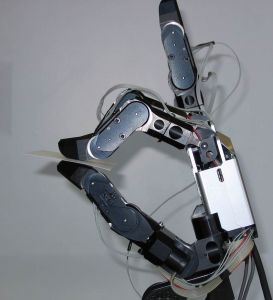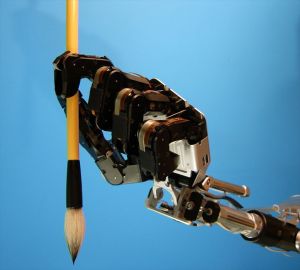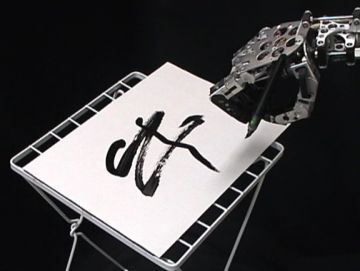TSUKUBA FUTURE
#027 Understanding How the Brainworks by Creating Robot Hands
Professor HOSHINO Kiyoshi, Faculty of Engineering, Information and Systems

Prof. Hoshino's area of interest is functions that accurately imitate the movement of the human hand, as opposed to equipping robots with intelligence. Robots of this kind would be useful to do work in the place of people, such as tasks in disaster areas, the harvesting of agricultural goods, and other complicated work to be done by remote control. For example, there are systems in which the working environment of an operator is connected by network to a robot so that the robot can replicate the actions that would normally be performed by a person. Though it is not fully automated, the robot can be commanded to accurately and flexibly do the intended work.
These are the robot hand systems and robot systems with arms and hands that have been developed so far. Appearance wise, it is apparent right away that they are machines, but the design was very exacting in order to get the same size and weight of the hand of a human adult. This is why creativity needed to be exercised in terms of the number and positioning of motors that are essential for accomplishing the kind of dexterous and complicated movements of which humans are capable. For example, there are a mere eight motors (joints) built into robot hand systems #1 and #2. These give these hands the diverse movements found in fingers. Unique to the fingers is the opening and closing movement. Though it is a kind of movement that tends to be overlooked, it is important for making a peace sign or expressing manual letters by sign language, so it makes possible detailed information communication by gesture. Robot hand systems #3 and #4 come with more small motors in the fingers so that they enable very human actions such as turning thin sheets of paper. For the arms as well, air pressure is used to develop robotic arm systems that move quickly, slowly, gracefully, and with strength.
The robot hand recognizes the signs of the manual alphabet made by the human hand and replicates them.
Humans have the ability to look at the shape of somebody else's hand and instantaneously replicate that shape. At such times, the human brain provides information that makes up for the blind spot. So what can be done to get a robot that does not have high-level artificial intelligence built in to perform the same feat? The idea that Prof. Hoshino and his associates came up with is to enable the robot to choose the closest shape from a database that stores data on hand shapes. Deploying all available staff in the lab, they constructed a database by photographing about 700,000 examples of conceivable hand shapes. A robot will capture the hand shape and at the ultra-high speed of 150 images per second access the database to output the shape that most resembles the shape detected.
We acquire various movements through a process of trial and error that is based not on any special learning but rather simply mimicking what those around us are doing. And it is not simply a case of "monkey see monkey do" but rather people comprehending the basic essence of movement as they imitate, so if it is possible to create robots that can replicate human movements through imitation, they would not need to be programmed to be able to perform various actions, and they should be capable of replicating things such as craftsmanship that is hard to quantitatively express.



The robot hand grips the writing brush and fluidly writes the character for "meat."
Prior to assuming his position at the University of Tsukuba, Prof. Hoshino pursued research at the University of the Ryukyus in Okinawa. Okinawa has its own unique dance culture. Upon trying the dance himself when invited to do so by locals, he felt that the style of dance had its own set of rules and was a form of communication that makes use of the body. He found the dancing very appealing to look at and it made him wonder how the brain controlled the limbs and to determine why he was not able to dance in the same manner as those around him. This was the experience that led him to launch his research into robotic hand systems.
Brain research tends to bring to mind an approach in which the internal structure of the brain is explored from a physiological perspective. This makes possible investigation of the minute workings of the brain at the molecular level, but it is not an approach that is well suited to ascertaining what the brain as a whole is attempting to do. In contrast, the research method of Prof. Hoshino is computational neuroscience, which likens the brain to a black box. This results in mathematical models that look at the calculations done by the brain on the basis of the relationship between what goes into the black box and then what comes out ? knowing what is inside the black box is not necessary to understanding. This method makes it possible to forecast how the brain will work. Though it is not possible to do experiments that involve removing a part of the brain to see what it would do with that part missing, it is possible to do calculations to see how changes in the parameters of mathematical formulas alter the output. And this leads to applications in the diagnosis of illness because the process identifies factors that occur from a certain state.
There is no need to make robots look like people in order to achieve greater work efficiency or higher performance. And yet, Prof. Hoshino sees the human hand as the model to which he aspires. This is a crucial point that needs to be borne because the eventual goal is a robotic hand system that works as a prosthetic hand. It is also doubtless that every person has thought at least once that it would be nice to have an extra hand available. The prosthetic hand that Prof. Hoshino has in mind is the third or fourth hand that would be attached at such times.
Student autonomy is respected in the selection of research subjects. The figures and trophies in front are mementos
The human brain skillfully controls two arms, but those two arms are not capable of work independent of one another. One has dominant movement and the other has subordinate movement. Even if the two arms appear to be multitasking, within the brain the instructions might be those that are for one overall task. If it became possible for a third arm to independently take on a completely different task, that alone could enable a person to do the work of one more person.
The Senju Kannon, or Thousand-Armed Bodhisattva of Compassion, is said to have saved many people simultaneously. Since each arm has its own eye, it is conceivable that the Kannon alone does not control the thousand hands but instead each hand works independently. The robotic hand systems of Prof. Hoshino might ultimately become the robotic equivalent of the Thousand-Armed Kannon by assisting people through handling many tasks simultaneously.
Article by Science Communicator at the Office of Public Relations


